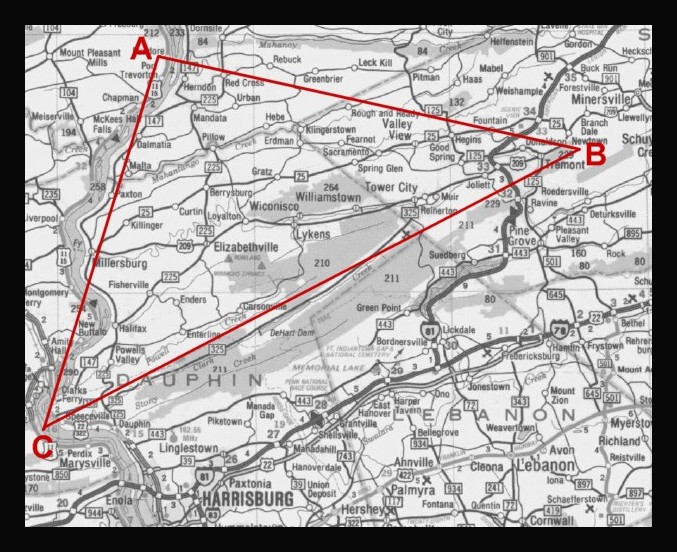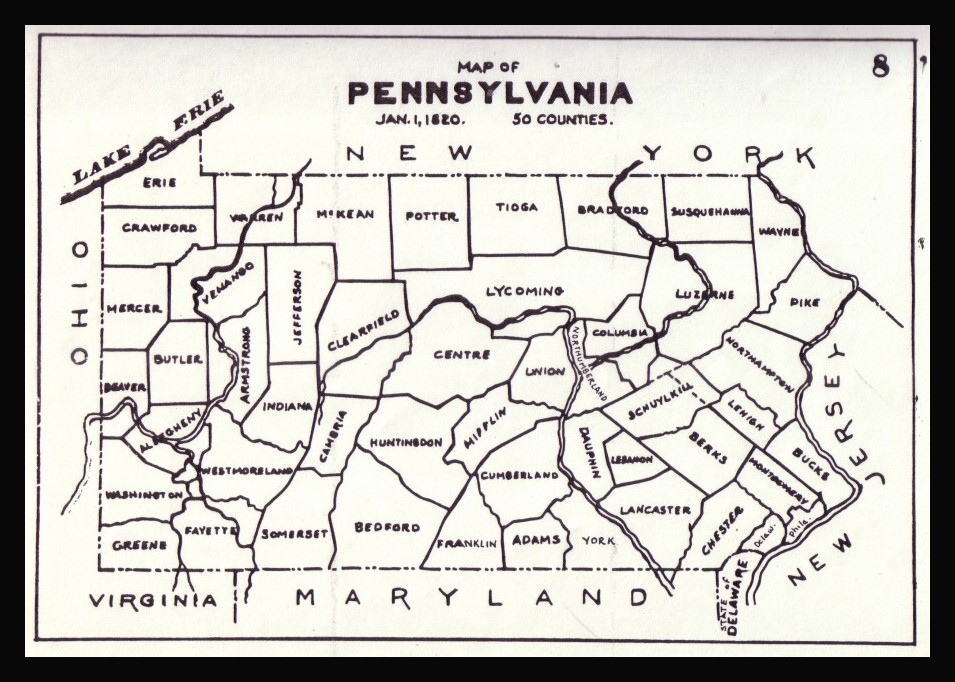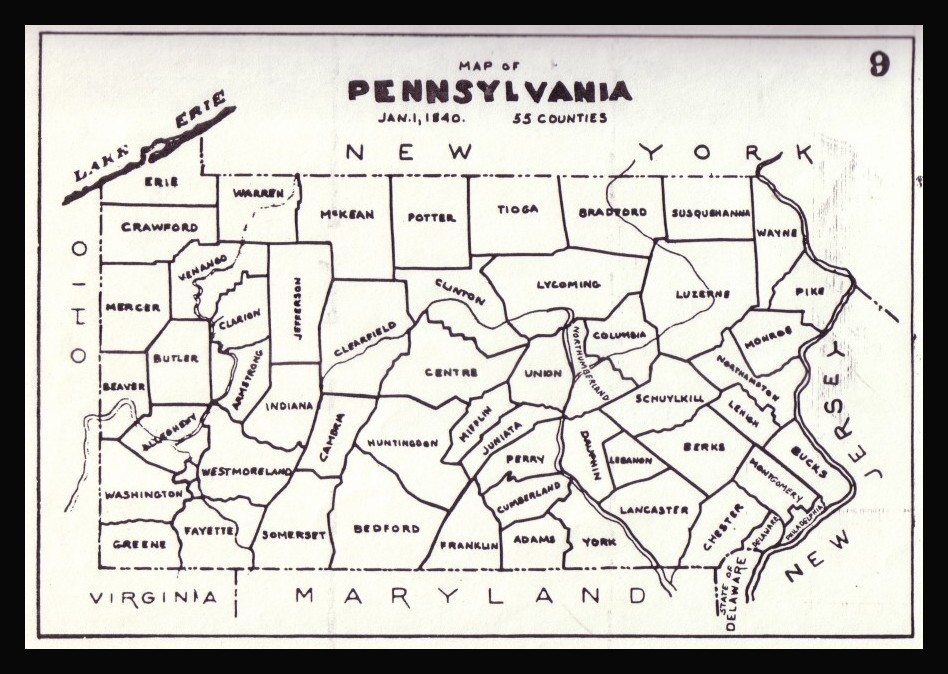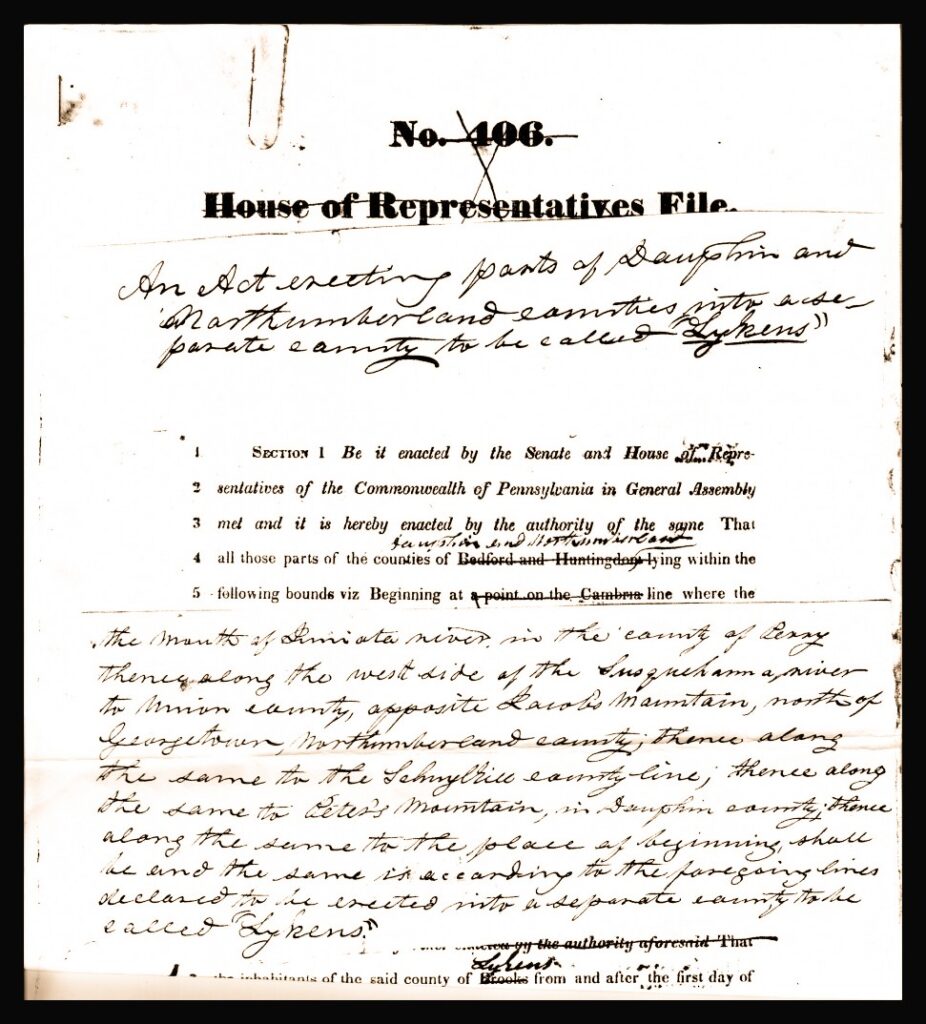The geographical area encompassing the Lykens Valley Area was not arbitrarily chosen. There is a long-standing historical, economic and cultural identity in the parts of three counties that form the large triangle of valleys in the east-central area of Pennsylvania through which the Susquehanna River flows. The lower part of Northumberland County, the upper part of Dauphin County and the western part of Schuylkill County seem have more in common with each other than they do with the part of their counties that contain their county seats of Sunbury, Harrisburg and Pottsville respectively.
The actual geographical limits of the place officially called the Lykens Valley are entirely within the northern end of Dauphin County. But, for anyone studying the history of the “northern end” or “upper end”, records and histories would have to be studied from the parts of the two neighboring counties as well as those from Dauphin. There are similar geographic features, common family histories, transportation and communication networks, etc.
But, for whatever reason, this geographical area never became a county unto itself. There were attempts to do so, but they failed.
As Pennsylvania developed in the 18th and 19th centuries, counties were formed out of parts of other counties and there were constant attempts to create new counties. When the costs of administering outlying areas of an existing county became too great for the more established areas to handle, the political will was not there to resist secessionist movements.
Previously, a set of maps was presented to show the development of Pennsylvania’s counties. See: Historical County Maps of Pennsylvania.
Map #8 from the set shows the existing counties in 1820:
From Map #8, Dauphin County, Northumberland County, and Schuylkill County boundaries had been established by 1820.
Next is shown Map #9, for 1840:
In comparing the two maps, it is noticed that only 6 new counties were created during this 20 year period – five were west and one was east of the Susquehanna River.
However, there were unsuccessful attempts to create new counties out of existing counties. One such attempt, in 1834, was the proposal to create “Lykens County” out of parts of Dauphin, Northumberland and Schuylkill Counties. Of course, the attempt failed. However, records were left regarding this proposal.
Several years ago a copy of a “draft” act to create a new county out of existing parts of Dauphin and Northumberland Counties (and parts of Schuylkill although not stated in the act title) was found in the Pennsylvania State Archives. A portion of that “draft” (7 pages total) is shown above.
The new county boundaries were to be established as follows:
The mouth of Juniata River in the County of Perry, thence along the west side of the Susquehanna River to Union County, opposite Jacob’s Mountain, north of Georgetown [Dalmatia], Northumberland County, thence along the same to the Schuylkill County line, thence along the same to Peter’s Mountain, in Dauphin County, thence along the same to the place of beginning, shall be and the same in accordance to the foregoing lines declared to be erected into a separate county to be called Lykens.
The county seat of this new Lykens County was to be established at Millersburg, with the temporary court house and administrative center to be at the Methodist Meeting House there – until such time as an election could take place and the citizens erect a permanent court house.
The act was presented to committee for review.
On 15 February 1834, the Sunbury Workingmen’s Advocate reported:
Mr. Frailey [representative from Schuylkill County] moved that the committee be discharged from the further consideration of the subject of certain petitions for a new county out of parts of Dauphin, Northumberland and Schuylkill. Mr. Ayres [representative from Dauphin County] moved that the committee be instructed to report a bill, forming a new county to be called “LYKENS” and supported his view with some remarks. Mr. Frailey stated the facts of the number of petitions, etc. The committee was discharged.
The citizens who petitioned to form a new county were not dissuaded and they continued to agitate and petition up though 1841, when the Pottsville Miners Journal of 30 January 1841 stated:
Petitions have been presented to the Legislature for the formation of a new county out of parts of Schuylkill, Dauphin and Northumberland. The new county would embrace the two Mahantongos. We go in for the new county. The Mahantongos have always been an expense to Schuylkill, and the sooner they are cut off the better.
What must be noted here is that the rapidly increasing population in Schuylkill County in this time period was the reason that the citizens of that county were petitioning for moving the county seat from Orwigsburg to Pottsville. Rep. Frailey lived in Orwigsburg and had political and economic interests there and keeping the county seat in Orwigsburg was to his economic advantage. Likewise, a larger county with Orwigsburg as its county seat was to his advantage as well. Thus, he resisted the attempts to move the county seat as well as have any parts of the county break off and form other counties.
Further research must be done to determine all the reasons that Lykens County never came to be. Some of that research can be done by examining more closely the lives and careers of those who supported and resisted the formation of Lykens County.
Frailey was Charles Frailey (1797-1873). He served as a state representative from Schuylkill County in 1833 and 1835 and then as a state senator in 1836 and 1850.
Ayres was William Ayres (1788-1856). He served as a state representative from Dauphin County from 1833-1935.
The issue of the creation of counties from existing parts of Schuylkill County is briefly discussed on page 75 of Munsell’s History of Schuylkill County, published in 1881, and available as a free download from GoogleBooks (click on title).
______________________________________
This story was first published on the Civil War Blog, September 19, 2013.
Corrections and additional information should be added as comments to this post.



